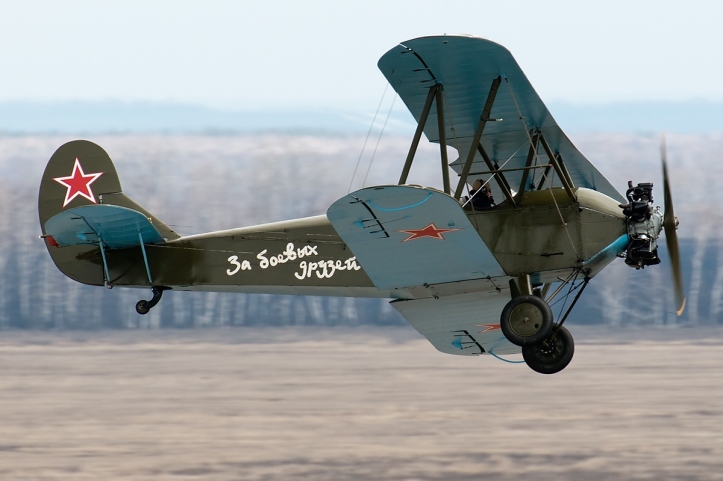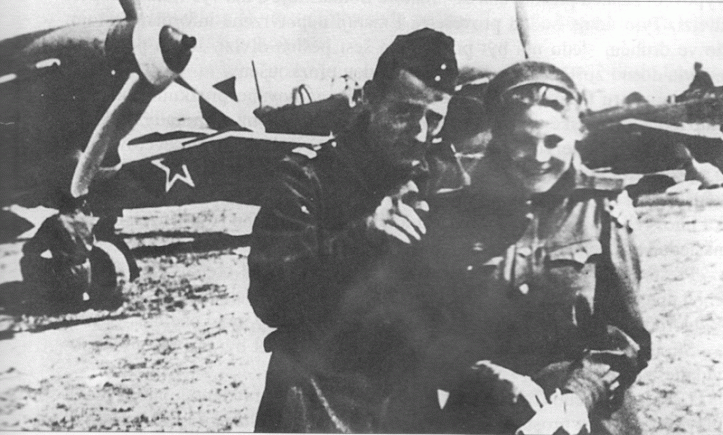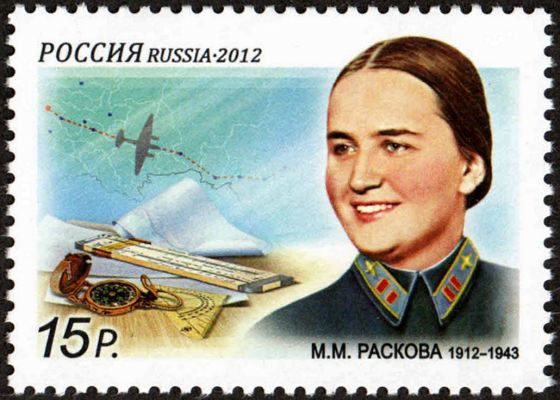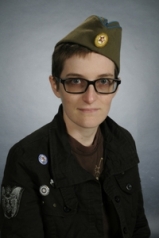
Just two years ago, the US Army finally opened all combat positions to women. What seemed like an obvious and badly belated move to many of us nevertheless triggered a resurgence of the perennial argument about women’s fitness for combat. The tired arguments that always get trotted out for why women shouldn’t serve in combat — physical fitness, unit cohesion, dirty vaginas — are dubious in any case, but to anyone who has studied WWII Soviet history, they’re just plain hilarious. It turns out that there’s no question as to whether women can serve in combat. They already have. And they didn’t just serve: they kicked ass.
Unlike the other Allied nations where women were restricted to non-combat positions like nurses, the Soviet Union recruited thousands of women to serve in all kinds of positions both in and out of combat, from partisans to tank commanders. Women were especially prized as snipers, since they were believed to be more focused and patient than men; top sniper Lyudmila Pavlichenko racked up over 300 kills. By the end of the war, women were estimated to make up about 10% of the Soviet military.
But I’m going to talk about some of the most fascinating women of World War II: the members of the all-female Aviation Group 122. Russian women had long been involved in aviation beginning with World War I recon pilot and fabulous hat-wearer Princess Eugenie Shakhovskaya. Flying clubs were popular among Soviet youth of both genders. When Germany invaded, there were many women with pilot’s licenses eager to get into combat. And by eager, I mean very eager, as pilot Yevgeniya Zhigulenko recounts:
There were several girls who had asked to go to the front, and they were turned down. So they stole a fighter plane and flew off to the front. They just couldn’t wait. (Strebe 15)
Celebrated navigator Marina Raskova, famed for the record-setting long-distance flight that ended with her surviving alone for ten days in the Siberian taiga, approached Stalin with an idea: an aviation group composed entirely of women, from the pilots to the navigators to the command staff. The result was Aviation Group 122, which eventually became three regiments: the 586th Fighter Regiment, the 125th Guards Dive Bomber Regiment, and most famous of all, the 46th Guards Night Bomber Regiment.

So how did they do? Did they prove as capable as the male regiments? As if you need to ask.
The fighter regiment produced both of the world’s only female fighter aces: 11-kill Yekaterina Budanova and Lydia Litvyak, the famed “White Rose of Stalingrad,” credited with 12 solo and four joint kills. Budanova and Litvyak operated as free hunters, pairs of elite pilots who prowled for enemy planes like total bosses. According to legend, Litvyak painted white flowers on her plane’s fuselage and German fighter pilots would flee when they saw them.
The dive bomber regiment, initially commanded by Raskova herself, faced a lot of skepticism about its airwomen’s ability to handle the high-tech Pe-2, a twin-tailed bomber feared by rookie pilots and beloved by talented ones. Flying the Pe-2 was demanding both mentally and physically. The pilot often had to brace against the navigator’s back in order to pull back the control stick with enough force to get the plane off the ground, and recharging the machine gun required 60 kilograms of force. But the 125th performed well and five of its airwomen were decorated as Heroes of the Soviet Union, the USSR’s highest honor.
Then there were the night bombers. Flying small, antiquated wood-and-canvas biplanes that were designed to be trainers and equipped with no parachutes, no radios, and only the most rudimentary instruments, they didn’t exactly have success dropped in their laps, yet they became one of the most decorated Soviet air regiments, flying some 24,000 combat sorties and producing 24 Heroes of the Soviet Union. The Germans were terrified of them. According to one POW, “When the women started bombing our trenches…the radio stations on this line warned all the troops, ‘Attention, attention, the ladies are in the air, stay at your shelter'” (Noggle 46).
It was the Germans who gave them the name by which they were best known. Mechanic Nina Yegorova says:
The Germans called the crews night witches. They liked to sleep at night, and our aircraft made the Germans’ life not so easy; they disturbed their sleep. Sometimes, when our planes were throttled back gliding in over the target, the Germans would cry out, “Night witches!”, and our crews could hear them. (Noggle 64)
The three women’s regiments were not restricted to safe missions or assigned to less hot parts of the front; they flew similar missions to the male regiments and ended up with more than their share of stories. Two 586th pilots, Raisa Surnachevskaya and Tamara Pamyatnykh, received a surprise when they were scrambled to intercept two enemy aircraft, but discovered that there had been a miscommunication and there were actually forty-two enemy aircraft. Surnachevskaya recounts:
At first we thought they must be birds, there were so many of them. Then we realized they were German dive bombers, they were approaching the railroad station, and the station was full of trains. (Noggle 187)
When they radioed their commander for instructions, they received the order to attack. They dove through the formation twice, each shooting down a bomber on each pass, scattered the formation, and forced the bombers to drop their bombs in the fields and return without reaching their target. During the fight, Surnachevskaya saw Pamyatnykh hit:
My plane was not damaged by their gunfire, but Tamara’s plane was, and I was filled with despair when I saw her plane dropping away, spinning and on fire. (Noggle 187)
From Pamyatnykh’s perspective, the experience was even more dramatic:
I was being thrown about with so much force that my arms were flailing about, and I couldn’t even get hold of the seat belt. I had already opened the canopy. My life flew in front of my eyes. I wanted to jump, but I couldn’t open the belt. I didn’t feel fear, but I thought I was going to die. At last I got the belt open and I didn’t even jump—I was thrown out of the cockpit! I pulled the ring of my parachute, and it opened. When I landed, I started touching myself to see if I had injuries because I thought I had been severely wounded. I had blood on my face, and I felt very ill. My face was hurt, and the blood was running down. When my parachute opened, I was only 150 meters from the ground.
I looked up to the sky and saw that Raisa had circled around and was making another attack on the bombers. I thought, if she makes that attack she will never survive. I went to the telegraph station to report to my regiment that my aircraft was down and destroyed. Then I saw Raisa walking across a field, and it was wintertime, and there was snow, and we were in our fur boots. We came together and embraced each other and had the feeling that we had both been given birth again. (Noggle 160-161)
Pamyatnykh and Surnachevskaya would both survive the war, and Surnachevskaya also achieved the distinction of being probably the only person ever to fly in combat while pregnant.

Of course it wasn’t all miraculous survivals and victories against the odds. The Eastern Front was the most dangerous place to be during World War II and the airwomen of Aviation Group 122 were in the thick of it. They suffered heavy casualties, especially the 46th Guards in their fragile, flammable biplanes, and had all kinds of harrowing experiences. While American pilots decorated their aircraft with cartoons and pin-ups, the planes of the 46th Guards bore vows of vengeance.
At the beginning of the war, pilot Yevdokiya Nosal had just delivered a baby when her maternity hospital was bombed. She was rescued unharmed from the rubble. Her baby was not. She joined the 46th Guards with a score to settle. Her navigator recalls, “My pilot strove to fly as many operational sorties as possible every night. She certainly had a good reason to want to square her account with the Nazis” (Cottam 134).
Nosal, one of the 46th Guards’ best pilots, was later shot in the head while on a sortie. Her navigator was forced to fly the plane back on her own (the Po-2 had dual controls because it was a trainer), holding Nosal’s body up by the collar to keep it from slumping forward onto the control stick. Nosal posthumously became the regiment’s first Hero of the Soviet Union.
Any Westerner studying Aviation Group 122 can’t help being struck by both the similarities and the differences between their experiences and the experiences of Western women in nontraditional fields. The USSR was established on a foundation of egalitarian Bolshevism, and while it had taken a sharp turn to the right under Stalin, it remained far more progressive on gender issues than the West in many ways, most notably in the presence of women in every sector of the workforce. Thus, while the resistance many of the women met in learning to fly may seem familiar, the reasons given by 46th Guards pilot Antonina Bondareva are not:
Father was dead against it, though. Until then all members of my family had been steelworkers, with several generations of blast-furnace workers. My father believed that a woman could be a steelworker but never a pilot. (Pennington 9)

The women faced a lot of belittling and skepticism, especially at the beginning. When the 46th Guards arrived at the front, their division commander asked the commander of their air army, “I’ve received 112 little princesses. Just what am I supposed to do with them?” (Pennington 77) Male fighter pilots often refused to let the female pilots fly with them as wingmen, ostensibly to protect them, but actually robbing the rookie pilots of the chance to fly alongside experienced veterans. And when Raskova brought in a male instructor to teach dive-bombing to the pilots of the 587th, he told her outright that it was ridiculous to think that women could learn dive-bombing. Once he had flown with them, he had to eat his words.
However, in many ways, the women’s air regiments were notable for the lack of special treatment they received. Valentin Markov, who commanded the 125th Guards, notes that “My superiors made no distinction between male and female units, of which the girls were very proud” (Cottam 22). They served in the same divisions with male regiments (the 586th and 125th both eventually incorporated some men), flew the same types of missions, and were issued men’s uniforms, right down to the underwear.
Although the selection process was stringent, they were never given a physical, not even the armorers, who were expected to wrangle 100-kilo bombs. Russians simply took the strength and hardiness of their women for granted. Meanwhile, across the pond, American WASPs were forbidden from flying while on their periods (an order that was, unsurprisingly, rarely followed, since their male superior officers didn’t want to ask).
The women of Aviation Group 122 were proud of their gender. 46th Guards chief of staff Irina Rakobolskaya says, “The first slogan of the regiment was: You are a woman, and you should be proud of that” (Noggle 29). Their all-female status was a particular point of pride for the 46th Guards, who were adamant about maintaining it. Historian Reina Pennington describes a visit from Rokossovskii, the commander of the front, and Vershinin, the commander of the air army:
Before the assembled regiment, Rokossovskii turned to Vershinin and said, “It’s probably hard for the girls to do everything themselves. Maybe we should send them ten or twenty men to help hang bombs and do other heavy work?” But the women protested loudly, “We don’t need any helpers, we’re managing just fine on our own!” (Pennington 74)
There is a curious tension between this pride (and the great lengths to which the airwomen went in order to serve) and the general agreement amongst them that it was unnatural for women to fight. 46th Guards navigator Alexandra Akimova expresses a typical opinion:
The very nature of a woman rejects the idea of fighting. A woman is born to give birth to children, to nurture…To be in the army in crucial periods is one thing, but to want to be in the military is not quite natural for a woman.
I think American women have the idea of romanticism connected with being in the military, and it leads them to want to be a part of it. That is probably because they have not fought a battle in their own country for a hundred years and don’t know the nature of war. If the women of the world united, war would never happen! (Noggle 94)
Nearly all of the other airwomen echo this sentiment. 586th formation commander Klavdiya Pankratova, however, disagrees:
I have a strong belief that it doesn’t matter whether it is a woman or a man at the controls; a woman can be a military pilot, she can fulfill combat missions if a misfortune like war falls upon the heads of the people of a country.
And then it came to who should retire. It was not the men, of course; I was made to retire, and I didn’t want to. (Noggle 184)
All three women’s regiments were disbanded at the end of the war and nearly all the women had to stop flying. Yet few of them expressed Pankratova’s frustration. Most of them were simply so grateful for the war to be over that they were glad to leave their military careers behind them and return to civilian life.

On an individual level, the airwomen ran the full spectrum of gender expression. On one end of the spectrum, some of them, especially those who had flown previously in male regiments or flight clubs, adopted traditionally masculine attitudes either through personal preference or as a way of legitimizing themselves as aviators. One such example is 46th Guards pilot Tatiana Makarova. Fellow pilot Natalya Melkin describes a teenaged Makarova this way:
Each morning, when everyone was still asleep, the thin girl in blue overalls rushed along her quiet street to the first streetcar…Always a little ashamed of looking too feminine and not at all like a pilot, Tanya, to make up for it, strove to put on a reckless and merry air, and purposely spoke in a somewhat rude tone, but she never succeeded in fooling anyone. (Cottam 159-160)
On the other hand, most of the women were unashamedly feminine in their gender presentation, none more so than Lydia Litvyak. According to a male pilot who flew with them, while Litvyak’s wingman and close friend, Katya Budanova, “hardly stood out from the fellows,” Litvyak was “a model of femininity and charm.” Her mechanic, Inna Pasportnikova, recounts:
Lilya [Lydia’s nickname] bleached her hair white, and she would send me to the hospital to get hydrogen peroxide liquid to do it. She took pieces of parachute, sewed them together, painted it different colors, and wrapped it around her neck.
Lilya was very fond of flowers, and whenever she saw them she picked them. She would arrive at the airfield early in the morning in the summer, pick a bucket of flowers, and spread them on the wings of her plane. (Noggle 196)
Rakobolskaya makes it clear that becoming soldiers did not mean that the airwomen had to become masculine:
Of course, we were not transformed overnight into a kind of pseudo-male soldiers. Girls stayed girls; they embroidered forget-me-nots on footcloths, flew kittens in their aircraft, danced on the airfield in non-operational weather and, at times, cried at the slightest provocation. However, most important, every day they fought better and better. (Cottam 117)
The individual stories of the women of Aviation Group 122 demonstrate the complete disconnect between gendered behaviors and combat performance. Litvyak and Budanova were complete opposites, but they both became aces. The women of all three regiments fought bravely, received many decorations, and earned the respect of all the men who had initially doubted them.
And, as far as I know, nobody ever had a problem with a dirty vagina.
Sources
Cottam, Kazimiera J., ed. Women in Air War: The Eastern Front of World War II. Newburyport, MA: Focus Publishing, 1998.
Milanetti, Gian Piero. Soviet Airwomen of the Great Patriotic War: A Pictorial History. Rome: Instituto Bibliografico Napoleone, 2013.
Noggle, Anne. A Dance with Death: Soviet Airwomen in World War II. College Station, TX: Texas A&M University Press, 1994.
Pennington, Reina. Wings, Women, & War: Soviet Airwomen in World War II Combat. Lawrence, Kansas: University Press of Kansas, 2001.
Strebe, Amy Goodpaster. Flying for Her Country: The American and Soviet Women Military Pilots of World War II. Dulles, Virginia: Potomac Books, 2011.

Gwen C. Katz is a writer, artist, and retired mad scientist. Her debut novel, Among the Red Stars, tells the story of the 46th Guards through the eyes of impetuous teen pilot Valka and her shy childhood sweetheart as they fight on opposite ends of the Eastern Front. It comes out on October 3; you can pre-order it here. Find Gwen on Twitter @gwenckatz.

[…] over at Dirty Sexy History, I tell the story of Aviation Group 122 and use the phrase “dirty […]
LikeLike
Reblogged this on History Rocks!.
LikeLiked by 1 person
Awesome!
LikeLiked by 1 person
[…] Source: Night Witches, Nazi Hunters, Heroes: The Women of Aviation Group 122 | Dirty, Sexy History […]
LikeLike
Hey awesome and thorough blog! I wrote about Pavlichenko on my blog- you might be interested in reading themilieux.org. My favorite quote of her’s was “Gentlemen, I am 25 years old and I have killed 309 fascist invaders by now. Don’t you think, gentlemen, that you have been hiding behind my back for too long?”
LikeLike